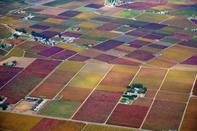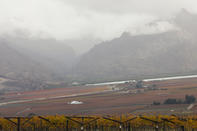The Hex River is a tributary of the Breede River, rising north-east of De Dooms. The mountains are the second highest mountain range in the Western Cape, 120 km northeast of Cape Town.
History of the Hex

In 1707, the Governor of the Cape Colony, William Adriaan van der Stel, eldest son of Simon van der Stel, was found guilty of mismanagement and of being corrupt after a revolt occurred in the Cape Colony. After spending time locked in the dungeon of Cape Castle he was exiled back to the Netherlands.
Van der Stel was the owner of Vergelgen Farm, a very successful farm, which was due to some extent by him thwarting any competition. Once he had been exiled, land rights into the interior were once again granted. Van der Stel, as Governor, had prevented any extensions from being permitted, in order to reduce competition with his own produce. The new extensions granted were next to the Sonderend and Breede Rivers in the Ex or X River Valley.
Granting of Farms
The first farmer to receive a licence for his stock to graze in the valley was Roelf Jantz van Hoeting. Other travelling stock farmers followed and by the end of the 18th century, six farms had been granted in the valley and the owners had built typical Cape Dutch farmstead homes.
The original farms granted in the Hex River Valley were as follows: (The order runs from the valley’s south-western entrance closest to Worcester to the north-east, closest to the Hex Valley Pass)
Kanetvlei (Kanet is the Afrikaans name for the Eligia Capensis, a marsh reed and vlei means marsh) Roodezand (Afrikaans for red river sand)
Vendutiekraal (Afrikaans for auction pen. Many travellers through the valley would buy livestock before departing on further travels northwards through the Karoo and livestock auctions supplied animals for this requirement)
Modderdrift (Afrikaans for muddy river crossing)
De Doorns (Afrikaans for the thorns, named for the prominent stands of Acacia Karoo trees)
Buffelskraal (Afrikaans for buffalo pen) Today, of the original six farms in the Hex River Valley, there are nearly 150 subdivisions.
A Haunting Story

The name of the valley is popularly attributed to the legend of the Hex of Hex River Valley. The name “Hex”, is the Dutch/Afrikaans word for witch. The legend is based on a true story, from 1768, during the very early days of the valley’s settlement. It is about the beautiful young Eliza Meiring, who lived with her family in the newly built manor house on Buffelskraal Farm, northeast of De Doorns.
The home is at the foot of Matroosberg Peak, and at 2249 m, Matroosberg is the second highest peak in the Western Cape. The young men in the area were all taken with Eliza’s beauty and elegance and so to deter the unwanted attention, Eliza challenged her would-be suitors to climb to the heights of Matroosberg peak, saying that she would marry the one who brought her a rare indigenous Disa Uniflora orchid from its treacherous heights.
Unbeknown to her, her favourite suitor decided to take up the challenge to surprise her but slipped and fell to his death. On hearing this tragic news, Eliza was racked with guilt and grief. Her mourning was so intense that she lost her mind and had to be confined to her home as all she wanted to do was head into the mountains to look for him. One day she tried to escape from an upper floor window but fell head first and was killed.
From this sad story the legend grew and it is said that at full moon Eliza’s spirit can be found wondering the mountain slopes of the Matroosberg, searching for her lost love. During the period of her confinement, she engraved her initials EM and the date 1768 in the glass windowpane of the room with a diamond ring. The window with the engraving was later removed during renovations to this beautifully preserved Cape Dutch homestead.
The Original Name
The valley was originally called the Ex River or X River and, as the first reference to this name for the valley is in 1715, this predates the story of Eliza. This name was coined at Sandhills, the southwestern entrance to the valley. One explanation is that the confluence of 3 rivers in the area formed an X shape and the other was that as the road was forced to repeatedly cross the river through the gorge, creating numerous X shaped crossings in the process.
The name was later changed from Ex River to Hex River. While the name derived from Ex River is the older name, the legend of the Hex of the Hex River is far more romantic and so, as most locals would agree, don’t let the facts get in the way of a good story!
 The Hex River Valley is the gateway between the Western Cape’s Boland region and the coast beyond to the south and the plains of the Great...
The Hex River Valley is the gateway between the Western Cape’s Boland region and the coast beyond to the south and the plains of the Great... This is where it all seems to hang together - the vines, the oak trees, the whitewashed houses and even the red and white roses planted next...
This is where it all seems to hang together - the vines, the oak trees, the whitewashed houses and even the red and white roses planted next...